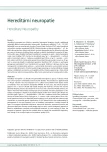Virtual Autopsy Performed by Magnetic Resonance Imaging – a Case Report
Authors:
M. Vaněčková 1; Z. Seidl 1,2; B. Goldová 3; I. Vítková 3; J. Kotlas 4; P. Petrovický 5; P. Calda 6
Authors‘ workplace:
Radiodiagnostická klinika, oddělení MR, 1. LF UK a VFN v Praze
1; Vysoká škola zdravotnická, Praha
2; Ústav patologie 1. LF UK a VFN v Praze
3; Ústav biologie a lékařské genetiky 1. LF UK a VFN v Praze
4; Anatomický ústav 1. LF UK v Praze
5; Gynekologicko-porodnická klinika 1. LF UK a VFN v Praze
6
Published in:
Cesk Slov Neurol N 2009; 72/105(1): 73-76
Category:
Case Report
Overview
Post mortem magnetic resonance imaging (MRI) has shown to be a complementary method to autopsy in determining fetus malformation. It may even play a key role when autopsy is limited by such factors as brain autolysis, ventricular dilatation or impossibility to perform fixation of the brain. Post mortem MRI also allows for imaging the development of the fetus; this is important for a correct interpretation and deeper understanding fetus malformations. In this case report, we describe two cases of CNS malformations (corpus callosum agenesis, occipital encephalocele), where a comparison of the prenatal ultrasound, post mortem MRI and pathological-anatomical autopsy was performed. Most information was obtained by magnetic resonance; pathological-anatomical autopsy was insufficient due to autolysis (corpus callosum agenesis). Because of severe malformation in the case of encephalocele, all three diagnostic methods were in agreement.
Key words:
magnetic resonance imaging – autopsy – fetus – malformations
Sources
1. Cartlidge PH, Dawson AT, Stewart JH, Vujanic GM. Value and quality of perinatal and infant post mortem examinations: Cohort analysis of 400 consecutive deaths. BMJ 1995; 310(6973): 155–158.
2. Griffiths PD, Paley MNJ, Whitby EH. Post mortem MRI as an adjunct to fetal or neonatal autopsy. Lancet 2005; 365(9466): 1217–1273.
3. Griffiths PD, Variend D, Evans M, Jones A, Wilkinson ID, Paley MNJ et al. Postmortem MR imaging of the fetal and stillborn central nervous system. AJNR Am J Neuroradiol 2003; 24(1): 22–27.
4. Garel C. MRI of the fetal brain. Berlin Heidelberg: Springer-Verlag 2004.
5. Seidl Z, Vaněčková M. Magnetická rezonance hlavy, mozku a páteře. 1st ed. Praha: Grada 2007.
6. Coakley FV, Glenn OA, Quayyum A, Barkovich AJ, Goldstein R, Filly RA. Fetal MRI: a developing technique for the developing patient. AJR Am J Roentgenol 2004; 182(1): 243–252.
7. Whitby EH, Paley MNJ, Cohen M, Griffiths PD. Post mortem fetal MRI: what do we learn from it? Eur J Radiol 2006; 57(2): 250–255.
8. Prayer D, Kasprian G, Krampl E, Ulm B, Witzani L, Prayerl et al. MRI of the normal fetal brain development. Eur J Radiol 2006; 57(2): 199–216.
9. Griffiths PD, Wilkinson ID, Variend S, Jones A, Paley MN, Whitby EH. Differential growth rates of the cerebellum and posterior fossa assessed by post mortem magnetic resonance imaging of the fetus: Implications for the pathogenesis of the chiari 2 deformity. Acta Radiol 2004; 45(2): 236–242.
Labels
Paediatric neurology Neurosurgery NeurologyArticle was published in
Czech and Slovak Neurology and Neurosurgery

2009 Issue 1
- Metamizole vs. Tramadol in Postoperative Analgesia
- Memantine in Dementia Therapy – Current Findings and Possible Future Applications
- Memantine Eases Daily Life for Patients and Caregivers
- Metamizole at a Glance and in Practice – Effective Non-Opioid Analgesic for All Ages
- Advances in the Treatment of Myasthenia Gravis on the Horizon
Most read in this issue
- Thrombotic Thrombocytopenic Purpura (TTP) in a Female Patient with Multiple Sclerosis – a Case Report
- Hereditary Neuropathy
- Prediction of Clinical Course of Herpes Simplex Encephalitis from Magnetic Resonance Imaging – a Case Report
- Differential Diagnosis of Neuroacanthocytosis
